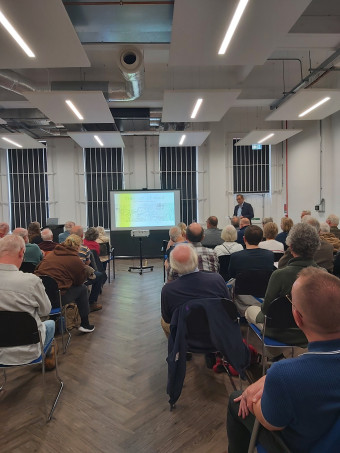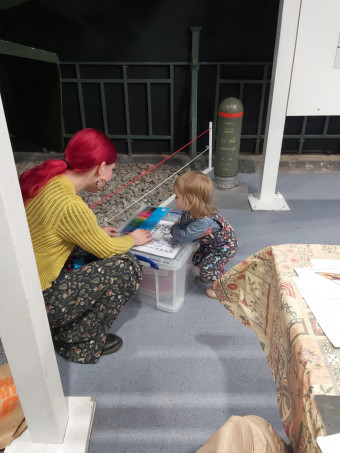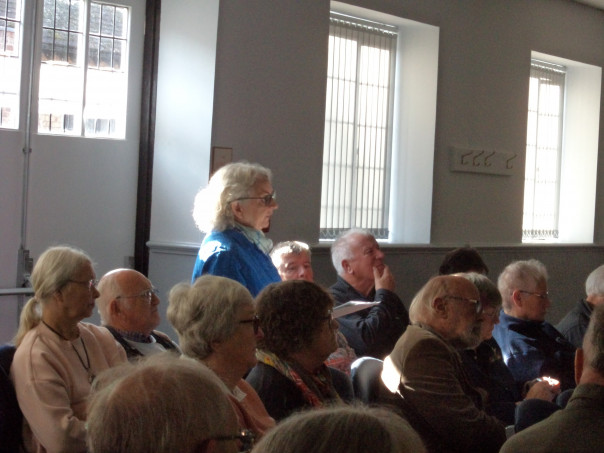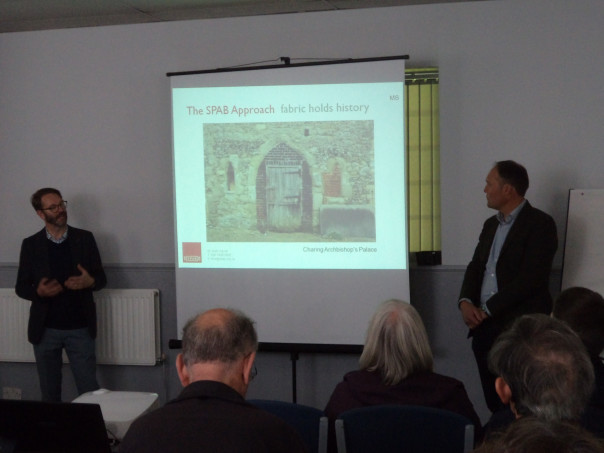Last Saturday was extremely busy for staff and postgraduates of the Centre for Kent History and Heritage because we were heavily involved in two major History events in Kent and reports and photos from these will form the bulk of the blog this week.
However, before I get to them, I want to flag up a couple of other matters. Firstly, Lizzie Burton has passed her Upgrade Review and will be giving the next Kent History Postgraduates presentation on Wednesday. She will provide ideas about her current research and where she is going next with her thesis, consequently this is just a note to record progress and to congratulate Lizzie on this milestone. The other matter I want to flag up is that as well as Jason Mazzocchi, another KHP who is the editor of the Kent Archaeological Society’s annual journal and Jacob Scott, the KAS webmaster, CKHH is now also represented on the Southern History board after a very long absence in terms of a Kent representative. Like Midland History and Northern History, Southern History not only includes county studies but equally multi-county studies thereby complementing such journals as Archaeologia Cantiana. If anyone is interested in joining Southern History, please have a look at the website and in addition to previous journals, you will see that they organise conferences: https://southernhistorysociety.org.uk/ . The one on ‘The experience of Garrison Towns in Southern England’ was very successful and there will be a new cfp for the next conference very shortly.

Now to the two events on Saturday and for the Medway History Showcase 2024, I’m turning to Jason who was not only looking after the CKHH exhibition stand at the Royal Engineers Museum, Gillingham, but also gave one of the presentations. Other presenters and exhibitors included Dr Diane Heath, and Professor Carolyn Oulton with Michelle Crowther. Equally, I want to record my thanks to Peter and Jane Joyce who have worked tirelessly with the Museum to put on the MHS 24 and are behind this very successful event, such days becoming wonderful ways to showcase the variety and depth of history and heritage going on throughout the county.

So now to Jason’s report and thanks Jason for this: The Royal Engineers Museum hosted the Medway History Showcase on Saturday 5th October which was a huge success. The well-attended day which had over 300 tickets booked in advance was led and organised by Peter Joyce and involved a programme of speakers throughout the day. Twenty-six exhibitors filled the two floors of the museum including Rochester Bridge Trust, CKHH, Medway Archives, Kent Archives, and other history and heritage organisations were delighted to discuss their activities and were available during the day.

Peter introduced the themes of the day, and the importance of raising awareness and questions on Medway’s history to an audience where there was standing room only. The first speaker was Adam Taylor who delivered an excellent presentation with 3D modelling and video-dynamic views of the landscape and archaeology of the Medway estuary. His talk on the Almost Lost Islands of the Medway Estuary revealed a light on the little-known histories of these islands, the people who lived on them and what they look like today, before they disappear from sea level rise and the ravages of erosion. Jason Mazzocchi presented his ideas on Memory and Identity in North Kent maritime communities in late Elizabethan and early Jacobean society and was followed by Stuart Bligh’s impressive historical biography of the maritime journey of William Harrison, from Harrietsham, and a captain of the clipper ship, Blackwell which he captained for 5 years between the UK and Australia, until his final voyage in 1872. To complete the speakers before lunch Diane Heath took an attentive audience through an enchanted journey of The Lost Bestiary Animals of Rochester.

The Royal Engineers Museum provided excellent catering facilities which attendees took full advantage of at lunchtime, and they also took the opportunity to survey all the exhibitors’ displays. In the afternoon the Showcase remained busy and audiences were engaged with a series of speakers which included talks by Dr Martin Watts on ‘Innocence Lost: Kent and the Battle of the Somme’; a presentation by the Orders and Medals Research Society, on ‘The Broken Sword VC’, CWGC on ‘Lost at Sea – The Chatham Naval Memorial’ and a final presentation by Martin Stoneham, former Chair of the Friends of the Royal Engineers Museum (FoREM).

The event closed with thank you from Peter Joyce on behalf of the Medway History Showcase, especially to Tom Paffett (of the Museum) who was tireless with his help to ensure that the event ran very smoothly throughout the day. So, the MHS is now done for another year, everyone had a fantastic day meeting lots of new and old friends amongst various historical groups.
The other event was at Aylesford Priory, the home of a community of Carmelite friars which had been re-established in 1949 after an absence of just over 400 years. For the medieval friary had been on this site between its foundation in 1242 and its dissolution by Thomas Cromwell’s agents as part of the destruction of the monasteries and other religious houses during the Henrician Reformation. Consequently, even though there has been a succession of new buildings over the centuries – from friary to gentry residence to friary – it was a great venue for the KAS Historic Buildings conference, especially because the theme this year was ‘Kent’s Religious Houses’.

Debbie Goacher, as chair of the Historic Buildings Group, opened the conference and welcomed attendees, including three KHPs: Tracey Dessoy, Maureen Mcleod and Jane Richardson. The first speaker was David Carder who provided a whistle-stop tour around the county’s monasteries and other religious houses. As you might expect, the most numerous were the Benedictine houses, including monasteries at the county’s two cathedrals by the later Anglo-Saxon period. Pre-dating these was the monastery at Canterbury established by Augustine and his followers. David briefly discussed the abbey’s early form and how it was altered and developed over time, the work of the last Anglo-Saxon abbot, for example, destroyed to provide its new Norman abbot with the chance to showcase the ‘sophistication’ of Norman architecture. In a similar vein, Archbishop Lanfranc, and then Anselm his successor undertook a corresponding strategy at Canterbury Cathedral, as Bishop Gundulf did at Rochester. Yet, as David reported, for most of these Benedictine houses very little remains and often even if part of the monastic complex survives, it has largely been incorporated to form a farm or domestic residence. Additionally, carved stones can often be found in buildings nearby, or, as at St Augustine’s Abbey, much of its masonry was shipped off to repair the fortifications at English Calais.
Taking this as his format, David discussed the female Benedictine houses before moving on to the far fewer Cluniac and Cistercian monasteries, the more numerous houses of Augustine canons of which Lesnes Abbey is a good example in terms of surviving ruins in parkland, and the two houses of Praemonstratensian canons. Interestingly, often the monastic gatehouses are well preserved in part because the post-Reformation gentry owners valued this status marker. Perhaps one of the most famous is Arden’s house which was the gatehouse of Faversham Abbey.

The next section of David’s presentation was the friaries, the most common orders being the Franciscans, the Carmelites, and the Dominicans, with the Austin friars at Canterbury and the Trinitarian friars at Mottenden. Like the monasteries, these too were dissolved in the later 1530s and equally were seen as desirable properties to be converted into gentry residences. Ruins do survive at some sites, but elsewhere buildings have been incorporated into later structures, thereby protecting part of the medieval fabric.
Leaving aside Kent’s medieval hospitals, David’s final section was on the secular colleges, and a previous Historic Buildings conference in 2019 had taken place at Cobham College, the best preserved because it was converted into an Elizabethan almshouse. The main building at Wye College also had medieval fabric, although this complex is currently being converted into expensive private apartments.
Having provided an excellent overview of the county’s medieval religious houses, David was followed by Dr Janet Clayton (a member of the KHP group) who spoke on ‘Orpington Priory’, which never was a religious house, albeit it was part of the Christ Church Priory grange or manor at Orpington, thereby highlighting how names can be deceptive! Janet began by providing a summary of the Priory’s recent history since it had come into the hands of Orpington local council in 1947 and how ODAS has now become heavily involved in providing open days and other outreach events where members talk to residents and visitors about its history, albeit some aspects are still not completely clear.

As a way of untangling some of these issues, Janet went back to the first known charter of 1032 when a chaplain in King Cnut’s household gave land to Christ Church Priory towards the monks’ clothing. The church at Orpington in this period was the mother church with one of its satellites being the church at St Mary Cray, the area having a few local settlements. By Domesday the local estates had been redistributed and, while Christ Church Priory retained Greater Orpington with 3 mills and 2 churches, they had lost out to Bishop Odo who had several local holdings. However, it is feasible to follow the priory’s buildings through the manorial bedels’ rolls at Canterbury Cathedral Archives and Prior Eastry’s memoranda book at the British Library. Taken together, they show that considerable improvements were made to the ‘Priory’ in the 13th century: new hall, new chapel, stone fireplace and hearth, with further improvements added by Prior Sellyng in the 1470s: stone fireplace, extra chambers. As Janet explained, Orpington’s location is a key feature here because it is close to the 3 major routes through Kent, it was an ideal staging post for those travelling between Canterbury and London (oats for horses, accommodation for priory officials), and it was on the route to Christ Church’s Surrey manors which contained several stone quarries.
The Priory itself remained in archiepiscopal hands post Dissolution, but the land went to the Crown and later the archbishop sold off the building, passing through more hands until it was owned by the Hughes family in the early 20th century, who had an interest in the Arts & Crafts Movement. Very fortunately detailed drawings were made in 1942 in case of serious war damage and in 1961 the new library building was added next to the existing structure with the museum in the old building. This all came to an end in 2016 when the museum was closed and subsequently the building is now held on a long-term lease to be used as artists’ studios. In conclusion, bringing the documents and building together has been an interesting challenge and a fascinating presentation, while Janet considers ODAS has made great progress but there is still more to be done.

Taking my cue from the idea of historic buildings, I explored Kent’s medieval hospitals from the standpoint that while it is often said that the ‘typical’ arrangement of the early hospitals resembled Christ Church Priory infirmary, and indeed some late medieval guild hospitals in York follow that format, by and large Kent’s hospitals adopted a considerable range of layouts, pragmatism was important, as was the identity of the patron. Other factors that seeming influenced the layout were the placement of sites, Kent having a considerable number of urban hospitals and finally the layout often changed over time.
With this as the context, I then went through the characteristics of the 4 main types of hospital by recipient, what these hospitals were like, or as much as we can say from often limited sources – documentary and physical features. Although my examples were mainly from east Kent, I did use St Mary’s hospital at Strood and St Bartholomew’s at Chatham, while for the well-endowed late medieval almshouse, I turned to William Milett’s Holy Trinity hospital at Dartford. This brought me to the considerable adaptations that some hospital patrons had undertaken, such as restricting the types of sick person housed, officially banning corrodians but then letting some in, Moreover, there was a considerable emphasis on working for the hospital’s community – in the brewhouse, bakehouse, and home farm; as well as on chantry provision, schooling, alms as out relief and the community of the living and the dead. Finally, we looked at several hospitals to see how there had been a move away from communal, dormitory-style living to individual dwellings – provision of chimneys key here, the value placed on communal feasts and other rituals, gender balance within hospitals and how this could change over time.

Taking a very different approach, Matthew Slocombe and Jonathan Garlick discussed the research and conservation work that SPAB have undertaken at the Old House/St Andrew’s chapel project next to Boxley Abbey. Having taken on the derelict property in 2018 and secured a very large loan from the Heritage Fund, they have worked with volunteers and professionals to restore the house using traditional materials and building methods. For those interested in seeing more, please check out the SPAB website: https://www.spab.org.uk/old-house-project and as a way of seeking to fund the next project, the restored property is now on the property market.
The final presentation was again given by David Carder who provided a brief history of Aylesford Priory before he and Debbie Goacher guided two groups on tours of this Carmelite friary, a fascinating end to an excellent day, so many thanks to all concerned.
 Centre for Kent History and Heritage
Centre for Kent History and Heritage Sheila Sweetinburgh
Sheila Sweetinburgh 1830
1830

